I first encountered Mick Otten’s photography through the interview I had with John Giskes about his butoh performances (see elsewhere on this site). I learned that he was, among other things, an underwater photographer.
I made an appointment with Mick Otten, who lives on a small square in a lovely green neighborhood on the outskirts of Maassluis. It turns out the neighborhood dates back to 1976.

The Storm in Motion (De Storm in Beweging)
We’re sitting at a large rectangular table made of heavy stained beams, a former weaving table from Indonesia. I see a lot of art on the walls around me. Mick Otten: “I first encountered John through his performance with several other performers in The Storm—hence the name of my blog, The Storm in Motion—at KunstPoortNoord. I was immediately intrigued by the visual aspect of butoh theatre: frozen movements, slow motion, a still slightly alive image. The Storm no longer exists, but I’ve been following John Giskes as a solo performer, sometimes in the company of other artists.”

Nature Art
Mick Otten’s photography has evolved in recent years towards visual art. He detaches sea creatures, sometimes very small ones, from their surroundings and captures them against a black background. “I call it ‘nature art,’ I want to see sea creatures as pure art, not just in nature. This allows me to capture special movements; you see the animals at their best. You can compare it to how a jeweler displays his wares, against a background of black or dark blue felt.”
In recent years, he has created a series of underwater photographs, both in nature and in vitro (literally ‘behind glass’). Mick Otten was fascinated by the sea and its life from a young age; it was a major hobby of his father, who had a cold-water marine aquarium and took him on excursions to Zeeland.
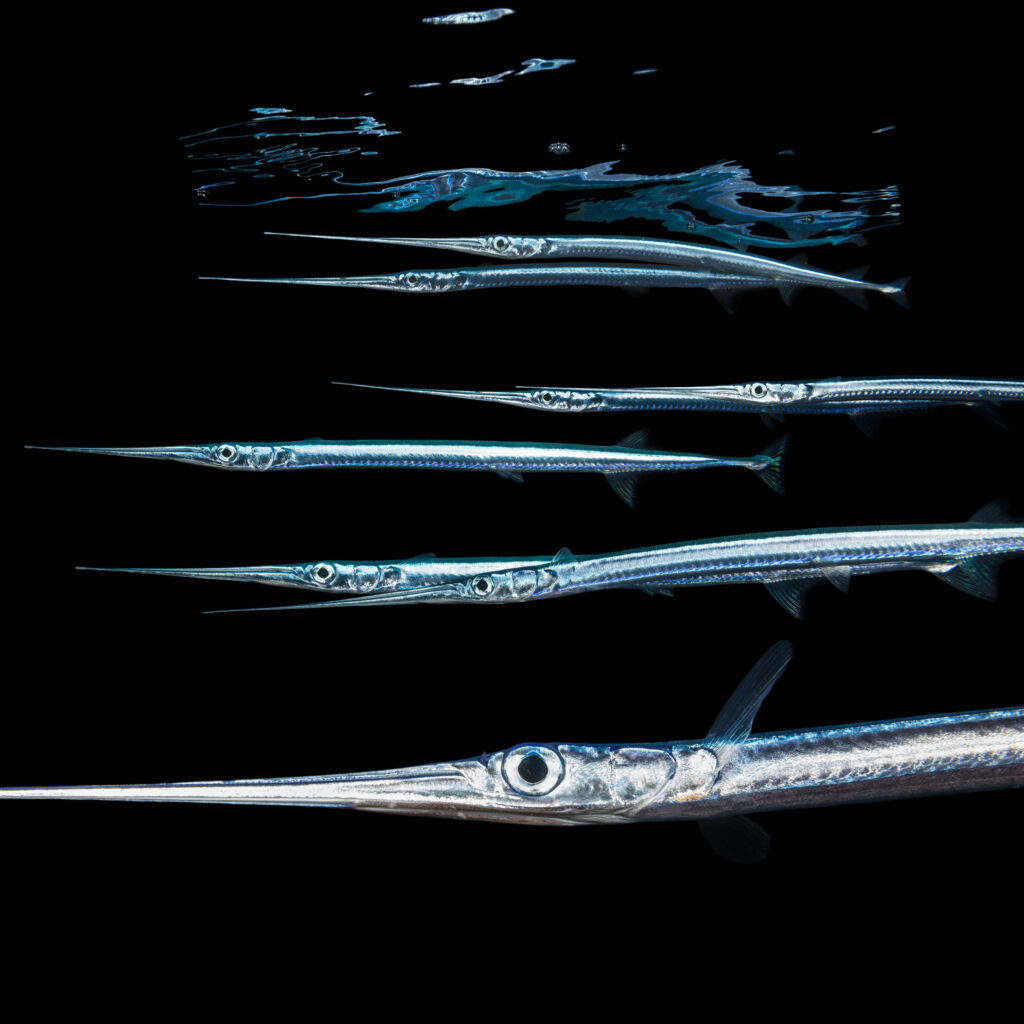
Underwater Photos
He takes underwater photos almost every week while diving. These are often relatively small marine animals, which he searches for in Zeeland waters like Lake Grevelingen and the Oosterschelde and Westerschelde (in Zeeland). But he also photographs these (collected) animals above water. “I use the diving photos sparingly in my art photography; they’re usually too documentary-like. I remove the background digitally. But sometimes it doesn’t work, like when I was working on the photo of a sea anemone. I ‘cleaned it up,’ but the tentacles were so transparent that you could still see the background through them.”

A detour
Otten’s education and subsequent work did not immediately point in this direction. He graduated in 1981 from the Reinwardt Academy, a program for professionals in the cultural heritage sector, such as museums.
However, in those years, the Dutch economy was at a low point and unemployment was high. He looked elsewhere and ended up, successively, at the development aid organization Terre des Hommes, a few years later at the Foundation for Consumer Dispute Resolution Committees, and, from 2001, at a housing association.
But it remained a bit of a sore point, the culture, nature and especially photography remained in his thoughts.

Choosing photography
“I found a sponsor: my wife, and I chose photography. In 2007-’08, I took the photographic design course at the Fotovakschool (Photography School). I was 46 and back in school! I had barely dabbled in photo editing/Photoshop. That was new to me. I completed the course. It gave me joy to be able to build that career a bit.”
He immediately landed on a lucky break. “The first assignment came from a community worker I’d worked with extensively in my work at the housing association. ‘Can you organize a photo exhibition with photos of all the bridges in North Rotterdam?’ That was a stroke of luck. I set up my company, didn’t know what to charge, and didn’t ask for too much. That’s how I got involved. The exhibition was held, and the response was positive. The photos were in black and white. I had plenty of room to use my imagination. Some bridges have something special, but others don’t. I had to come up with an original approach. I walked around them several times, and often an idea would pop up. At the bottom of a bridge, I saw a homeless person in a sleeping bag; he had a beautiful face. ‘I want to photograph that. With the bridge in it.’ It turned into a beautiful photo. That way, it all became a beautiful whole.”
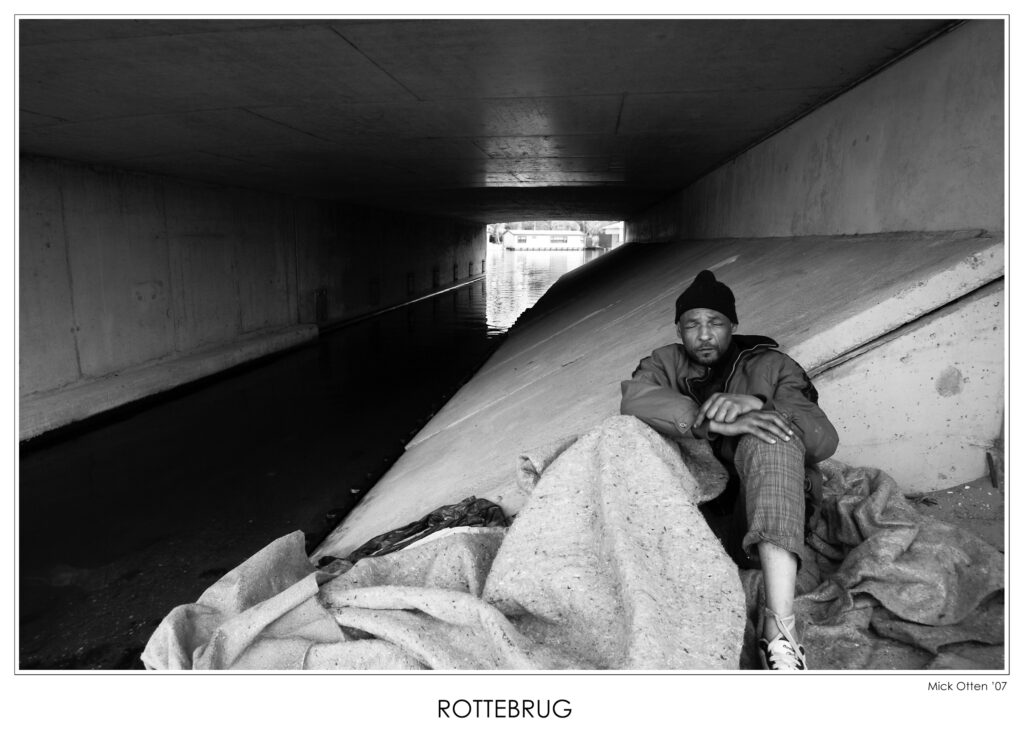
Power Neighborhoods
This assignment led to other assignments. In 2008, Minister Vogelaar published a memorandum about 40 deprived neighborhoods that she wanted to transform into power (developing) neighborhoods. “The same community worker who worked for the Bergpolder Residents’ Organization (Bergpolder was one such neighborhood) approached me. I had a conversation with him and a ‘neighborhood coordinator’ from the then-submunicipality of Noord. They wanted to have a booklet made about 10 residents’ initiatives that would be presented to Vogelaar. I replied: ‘That’ll be boring. My alternative: I’ll take photos of the people carrying out those 10 projects. I’ll mount the A3-sized photo print on cardboard and put a text about the project on the back. At the presentation, these people would give Minister Vogelaar their photo’. If it had been a booklet, someone would have handed it to her, and that would have been the end of it. Now, representatives from all the projects could present the photo and text of their own project. That made those people proud. The proposal was accepted. Vogelaar came to visit, and it went very well. “

Bergpolder-Krachtwijk and NOORD010inbeeld
Immediately after Minister Vogelaar’s visit, Otten started a blog about Bergpolder titled ‘Bergpolder Krachtwijk’. The residents’ organization and the Noord district proved very interested, and three weeks later, it became paid work. It generated a decent income. It was a nice combination of photos and text. After a while, Otten knew Bergpolder better than his hometown of Maassluis (where he has lived since 1987).
He had been working on it for five years when the Noord district announced it would stop funding. So he thought it wise to expand it to all of Rotterdam-Noord. “I approached another photographer from Oude Noorden, Johannes Odé, and together we created a blog and Facebook page ‘NOORD010inbeeld’. The district found that appealing. When the districts were abolished nationwide, the municipality announced they wanted to discontinue the blog. That was the moment for me to stop. Johannes kept the Facebook page going.”
Nature takes center stage.
After that, from 2013 onward, his photography increasingly focused on nature, particularly beach landscapes and marine fauna and flora. “Sand structures on the beach formed by the wind, washed-up objects, and water draining from the beach. In Ouddorp, peat remnants formed beautiful patterns in the draining water; in New Zealand, where we were on vacation, lava sand created beautiful ‘drawings.’ I went canoeing and photographed sandbanks in the Western Scheldt.” He began exhibiting these photos.
Since 2013, he has participated in the annual Maassluis Art Route, initially with photos of beach landscapes and trees, but later with sea creatures on a black background. “That has become my specialty.” He now also participates in the Westland and Wemeldinge art routes.
What fascinates him so much about marine flora and fauna?
“I never tire of photographing unique marine creatures. Sometimes people think you have to go to tropical regions for that. That’s not necessary. Our sea is home to fantastically beautiful creatures. I display them as works of art. I want to show them to others too; that’s a major motivation, along with emphasizing the importance of protecting them. If people don’t know what lives in our sea, they don’t know what to protect. For example, it doesn’t help when Rijkswaterstaat (the Directorate-General for Public Works and Water Management) deposits steel slag in the Eastern and Western Scheldt estuaries. I regularly give lectures on Dutch marine flora and fauna to anyone who’s interested. These could be natural history societies and photography clubs, or even residents of a nursing home. For this photography, I do depend on availability; nature can’t be forced. That has become somewhat less so in the last year.”
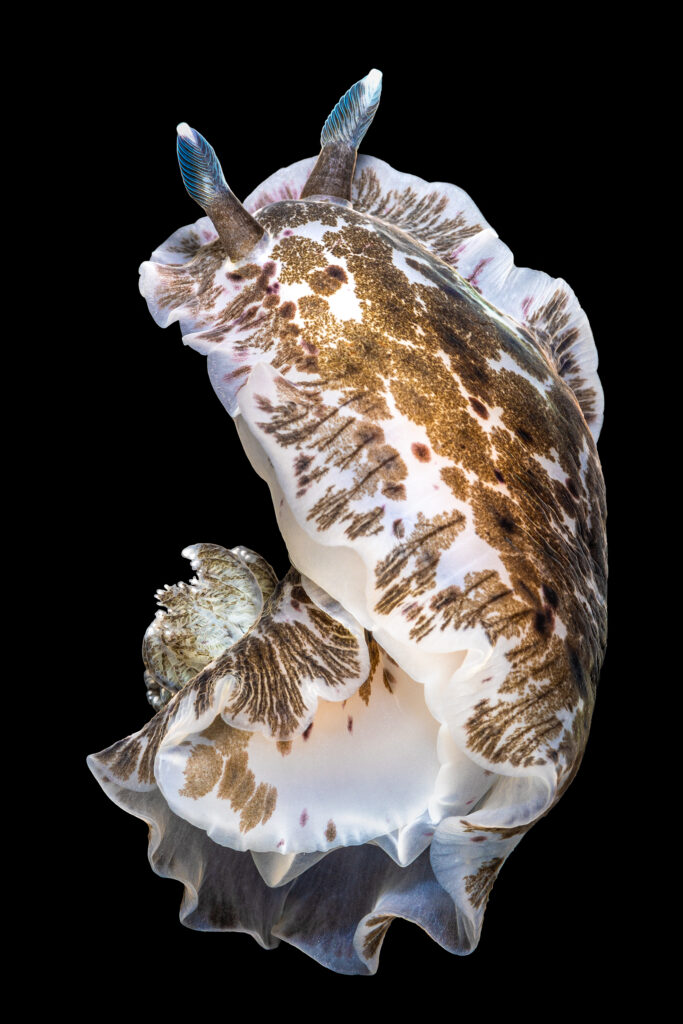
How do you work?
“For the in vitro photographs, I collect the often small animals while diving or at low tide. At home, I capture them with a macro setup on the kitchen counter. I place the animals in water in a black plastic container or a petri dish with a black background. I make sure the animal moves in a certain way to capture the best photo. This takes a lot of time, just like selecting and editing the photos. I then return the animals to the sea, to their natural habitat.
I have my photos printed using the ChromaLuxe process, which produces beautifully clear and sharp images. I have them printed at ARCA. They print a sheet of ink that’s placed on a thin sheet of aluminum. This is then compressed in an oven and heated to over 200°C. The ink is then vaporized into the aluminum.”
We’re going to look at the photo of a sea slug on the wall. It’s beautifully lit. “You see both the top and bottom of the animal. The pose it has here is something you never see in nature. The animals walk up the edge of the black plastic container, hollow their foot (which they use to walk) and float on the water. It becomes a kind of boat, so to speak. When the boat takes on water, it falls to the bottom. The animal then struggles to turn around. Eventually, it succeeds with the help of its foot. Then you see this beautiful torsion, this unique pose.” A very different work of the Rocket Meduse, a jellyfish barely 1 cm long, hangs on his wall, measuring 80 x 80 cm. His favorite photo.
Mick’s Marine Life and Mick’s Marine Biology
He also runs the blogs Mick’s Marine Biology and Mick’s Marine Life. “On Mick’s Marine Biology, I write about and showcase all sorts of unique marine animals, sometimes species that haven’t been found in the Netherlands before. Mick’s Marine Life is a kind of encyclopedia. I create a page for every species I photograph.” Many of his photos are also used on the websites of marine biology clubs. His photos also appear in magazines and books about marine fish, seaweed, and shells, among other things. He occasionally sells a photo abroad, such as the one he took in Newfoundland, of a dolphin and a whale.
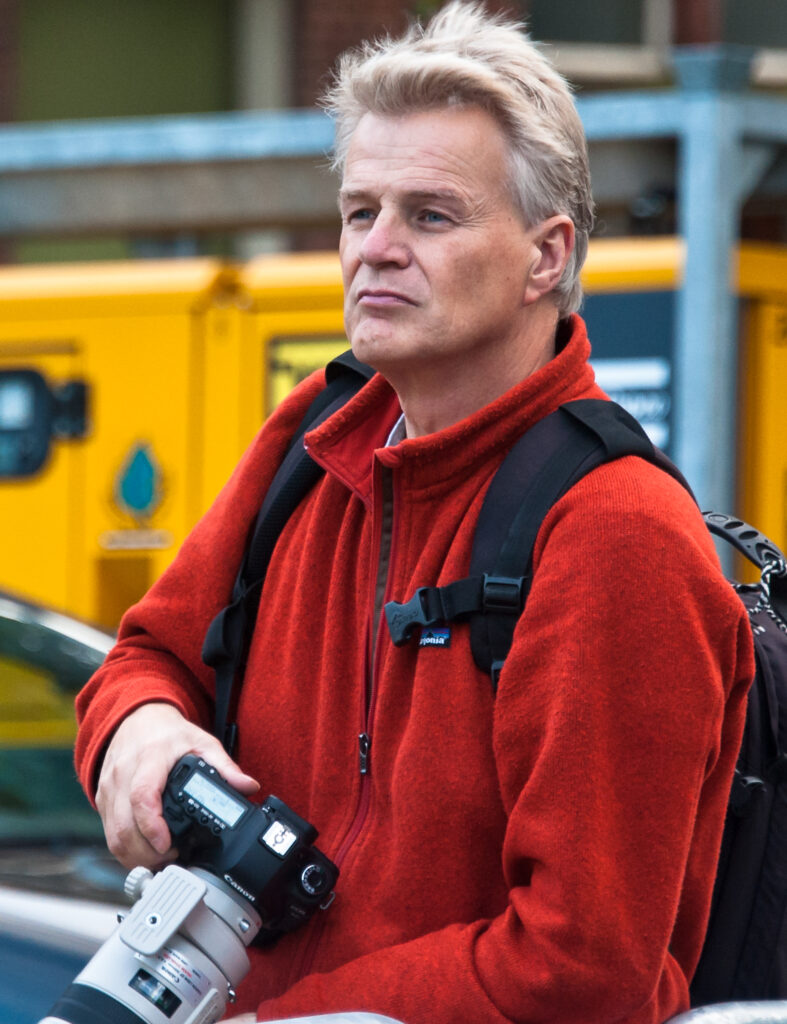
Excursions
For 44 years, Otten has chaired the Waterweg-Noord Beach Working Group, part of the KNNV (Royal Dutch Natural History Society). Through this Beach Working Group, he organizes around 25 excursions in Zeeland each year, searching for marine animals and seaweed at low tide. “Besides the regular participants—who come from all over the country and even from Belgium—we always see new faces. That’s important because it allows me to share my love and knowledge of marine life. As mentioned before: if you don’t know what special organisms live in our sea, you don’t know what to protect.”
Images
1)In Vitro 24 – Rocket Meduse, 2) The Last Cocoons (Storm in Motion), 3) Shadow & Light Session 1 (Storm in Motion), 4) In Natura 10 – Garfish, 5) In Vitro 21 – Blue Tip, 6) A Sea Full of Fish, 7) Building a Bridge in Noord, 8) Bergpolder Takes Action, 9) In Vitro 28 – Marbled Snail, 10) Mick Otten @ Johannes Odé, 2012
https://nieuwewendingproducties.blogspot.com/
https://micksmarinebiology.blogspot.com/
https://micksmarinelife.blogspot.com
https://destorminbeweging.blogspot.com
https://inzaken.eu/index.php/2025/11/06/mick-otten-bij-ons-in-zee-zitten-fantastisch-mooie-dieren/


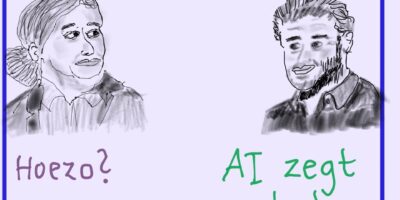
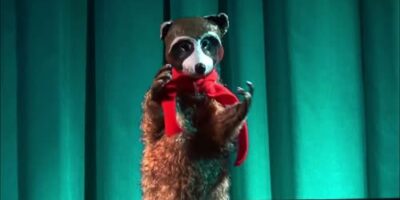




Leave a Reply